Kenneth L. Gentry Jr.'s Blog, page 93
December 16, 2016
NOT “UNDER LAW”? (2)
[image error]PMT 2016-092 by Kenneth L. Gentry, Jr.
This article continues and concludes the previous one. I am showing that the New Testament does not set aside God’s law as a righteous standard for all men.
Paul’s Liberty in Christ
We must comment on the meaning of his tricky statement.
First, when Paul refers to Christ’s “law” he appears to mean Christ’s “authority” (cp. Mt. 28:18; Eph. 1:21; Phil. 2:9-10; Col. 1:17-1) — not a new system of laws and obligations. Paul is under Christ’s lordship; he is Christ’s servant or slave (1 Cor. 9:16-17; 7:22). Paul’s fuller statement that he is “under law to God” is validated by being under Christ’s law or authority. Being a servant of Christ does not remove the obligation to God’s Law. Remember, the whole debate was about Christian liberty (1 Cor. 8:9; 9:1a,19; cp. Gal. 2:4) — liberty in Christ. Here he asserts again that our liberty is not a wholesale, unbridled liberty, but one constrained by obligations to Christ himself.
[image error]
Nourishment from the Word
(by Ken Gentry)
Reformed studies covering baptism, creation, creeds, tongues, God’s law, apologetics, and Revelation
See more study materials at: www.KennethGentry.com
When Paul highlights the distinction between Jew and Gentile (1 Cor. 9:19-21), he apparently assumes a distinction between being a servant of Moses (under his ceremonial and ritual authority) and a servant of Christ (with His superior authority, which fulfills those ceremonial obligations in Himself). He is under the new covenant in Christ rather than the old covenant administered by Moses. He is no longer obligated to Moses who was a “servant in God’s house,” but to Christ who is a “Son over the house” (Heb. 3:2-6).
The New Testament provides several examples of Christians’ being freed from ceremonial strictures because they are no longer “under Moses” but rather “under Christ.” For example, in Acts 6:14 we read: “we have heard him say that this Nazarene, Jesus, will destroy this place and alter the customs which Moses handed down to us.” See also: Acts 13:38-39; 15:1,5; 21:21.
Consider the strong adversative alla in the phrase “not being without the law of God but (alla) under the law of Christ.” This corrects any misunderstanding of Paul, and is a slap against the abusers of liberty. Not only is he not without the Law of God, but (strong disjunctive) he is under the authority of Christ. His original reader cannot jump on his “without law” and use the term anomos as if it meant “lawless.” He not only proclaims he is not without God’s Law, but is, in fact, under the authoritative lordship of Christ. This agrees with his declaration of his freedom from “all men” (1 Cor 9:19a), while maintaining the Christ-centered obligations within truly Christian liberty. Paul, then, is simultaneously under the Law of God and the authority of Christ. The two are compatible and co-extensive.
[image error]
Greatness of the Great Commission (by Ken Gentry)
An insightful analysis of the full implications of the great commission. Impacts postmillennialism as well as the whole Christian worldview.
See more study materials at: www.KennethGentry.com
Paul’s use of the phrase ennomos (“in lawed”) to refer to Christ’s “authority” rather than the more common word exousia is for literary reasons. Note his repetition of “law” (using various derivations of anomos):
to the ones under law as under law
tois hupo nomon hos hupo nomon
not being myself under law
me hon autos hupo nomon
in order that the ones under law I might gain
hina tous hupo nomon kerdeso
to the ones without law as without law
tois anomois hos anomos
not being without law of God
me hon anomos theou
but in law to Christ
all’ ennomos Christou
in order that I might win the ones without law
hina kerdano tous anomous
When he refers to Christ’s authority over his liberty by using a derivative of nomos, Paul maintains his literary cadence, driving home his point in style with this effective word-play. We must not let his literary technique cloud our understanding of his teaching.
Conclusion
Clearly then, a careful reading of this verse exposes the error of those who resist the application of God’s Law in the modern world.1 Rather than undermining God’s Law as a continuing ethical obligation, Paul here establishes the Law — just as he told us he would in Romans 3:31: “Do we then nullify the Law through faith? May it never be! On the contrary, we establish the Law.”
[image error]








December 13, 2016
NOT “UNDER LAW”? (1)
[image error]PMT 2016-091 by Kenneth L. Gentry, Jr.
Does God’s law apply to the new covenant era? Is postmillennialism lawless? Or does postmillennialism expect the worldwide influence of God’s law? Many Christians believe the law is God’s Law Emeritus. They believe the New Testament sets aside God’s law. But is this the case?
Many Christians believe that Paul sets aside the Old Testament law for “the law of Christ.” In 1 Corinthians 9:21, Paul wrote: “to those who are without law, [I am] as without law, though not being without the law of God but under the law of Christ, that I might win those who are without law.” The italicized phrases suggest that Paul here declares that in Christ — and, therefore, in the Christian era, our era — a new law prevails, which he calls: “the law of Christ.” This new law of Christ supplants the older law of God as the ethical norm for Christian behavior.
This statement has been badly misunderstood. Paul does not supplant the “law of God” with a new “law of Christ.”
Christ’s Law and Christ’s Teaching
Any supposed “law of Christ” must conform to Christ’s own teaching. And Christ said that He had not come to abolish the law, and that if anyone denied the least of the commandments he would be least in the kingdom of heaven (Mt. 5:17-20). Consequently, any “law of Christ” would harmonize with and support the original law of God. “The law of Christ” would not contradict the Law of God, but endorse it.
God’s Law and Paul’s Ethics
Paul clearly states (1 Cor. 9:19-20) that he does not keep the ceremonial aspects of the law, those Jewish-defining, ritual obligations demarcating Jews from the Gentiles. Then he adds: “though not being without the law of God,” that is, “though I am not without the law of God.”
[image error]
God’s Law Made Easy (by Ken Gentry)
Summary for the case for the continuing relevance of God’s Law.
See more study materials at: www.KennethGentry.com
The phrase “though not being without the law of God” shows the abiding relevance of “the law of God” in Paul’s ethical system. He most definitely is not without God’s law. Although he opposes mandatory observation of ceremonial features of the law, he is not “without the law of God.” This insertion is necessary to protect Paul’s argument from suggesting he endorses anomia, “lawlessness,” the word he employs in “without the law of God.”
This phrase harmonizes with his other observations on the continuing validity of God’s law as an ethical (not ceremonial) obligation in Paul’s writings: Romans 3:31; 7:12; 8:3-4; 1 Timothy 1:8-11; and so forth.
Paul’s Point Regarding the Law
Paul’s statement — “though not being without the law of God, but under the law of Christ” — must be interpreted as written. He does not contrast “the law of God” with “the law of Christ.” He did not say: “I am not under law to God, but rather I am under law to Christ,” as if they were two mutually-exclusive and competing ethical systems.
Note the double-negative. Double- negatives can easily trip up the interpreter. Paul does not state: “I am not under law to God.” Rather he declares that he is “not without law to God.” A world of difference separates these two assertions. He claims he is “not” in a state of being “without law to God.” Thus he denies he is “without law to God” or that he is “apart from” the law of God. In fact, he affirms that he is “under law to God” by denying he is “without” law to God.
To be continued.
Click on the following images for more information on these studies:


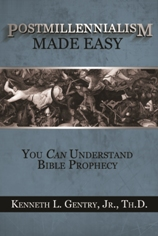








December 9, 2016
INCREDIBLE INDIAN CHRISTIANITY
 PMT 2016-090 by Jeremy Weber in Christianity Today
PMT 2016-090 by Jeremy Weber in Christianity Today
Gentry note: Christianity is experiencing growth in many unexpected parts of the world. Let’s pray for its continued growth and its growth into Reformed maturity.
The world’s most unexpected megachurch pastor might be an illiterate, barefoot father of five.
Bhagwana Lal grows maize and raises goats on a hilltop in Rajasthan, India’s largest state, famous for its supply of marble that graces the Taj Mahal. He belongs to the tribals: the cultural group below the Dalits, whose members are literally outcasts from India’s caste system (and often called “thumb signers” because of how they vote).
Yet every Sunday, his one-room church, with cheerful blue windows and ceiling fans barely six feet off the ground, pulls in 2,000 people. His indigenous congregation draws from local farmers, whose families’ members take turns attending so that someone is tending the family’s animals. The cracks in the church’s white outer walls are a source of pride: They mark the three times the building has been expanded.
Thousands of colorful flags stream down the sanctuary along the blue beams that support the corrugated metal roof. Their rustling approaches a roar.
When asked the reason for the flags, Lal responds, “For joy!” laughing heartily. The decorations are normally used at weddings. “The same feeling should be inside the church. People should feel this is God’s place.”
Yet consider a contrasting megachurch in southern India. A taxi drives under the shadow of Hyderabad’s four-story elevated train, whose massive support beams are marked with alternating colorful gods and goddesses. The roadside, lined with movie posters and squatter tents, gives way to clusters of large stone elephant-headed gods waiting to be painted with customary bright colors. The taxi turns into a dense traffic jam: a mile-long jumble of buses, motorcycles, and pedicabs surrounded by a throng of people on foot.
Amid the chaos, one detail jumps out: Many people have Bibles in hand.
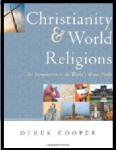
Christianity and the World Religions:
By Derek CooperCooper. Examines the rival worldviews found in Hinduism, Buddhism, Confucianism and Taoism, Judaism, Islam, and irreligion. He engages these worldviews from a Christian perspective.
See more study materials: www.KennethGentry.com
An ad above the corner bus stop reveals why: “Welcome to the largest church in India.” The crowd is departing from Calvary Temple-its 6 a.m. service, no less. The church can accommodate 35,000 people and fills each of its five Sunday services. Its Sunday school teaches 7,000 children.
Founding pastor Satish Kumar has just returned from speaking at Rick Warren’s Purpose-Driven Church Conference. He speaks between a thick fabric cross and a pulpit that replicates the facade of the church. When he asks his congregants to open their Bibles and turn to 1 Corinthians 13, the rustle of pages sounds like the rushing wind back at Lal’s church.
“Many Americans think nothing is happening among Christians in India,” says Kumar after the service. “We have to change that opinion.”
Christianity Today circled India from north to south and back again for two weeks in order to witness the innovative and successful mission efforts of Indian evangelicals-this, despite rising persecution from Hindu nationalists. In fact, evangelical leaders across India agree that their biggest challenge is not restrictions on religious freedom, but training enough pastors to disciple the surge of new believers from non-Christian backgrounds. They believe the church’s future in India is not a persecuted red (or rather, Hindu saffron) but a rosy one.
The best estimates of Indian Christians range from 25 to 60 million, with the majority being Catholics. That’s a tiny minority amid 1 billion Hindus, but still sizable enough to rank among the 25 countries with the most Christians, surpassing “Christian countries” such as Uganda and Greece.
This is why a US missions agency now trains its new cross-cultural workers in India alongside Indian counterparts. “This is real collaboration by the global church,” says P. Singh, a leading scholar at a respected Christian institution.
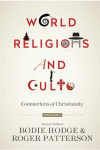
World Religions and Cults (Bodie Hodge, ed.)
This work is helpful for understanding and combating false religions and cults. It deals with the leading false religious beliefs in the world today.
See more study materials at: www.KennethGentry.com
Addressing mixed groups gathered at eight tables flanked by flags, Singh asks the trainees to share three stereotypes about each other’s homelands. The Indian lists for Americans include: “Hollywood, burgers, Donald Trump”; “punctual, disciplined, educated”; and “rich, white, luxury of choice.” The American lists for Indians include: “Hinduism, food, Bollywood”; “rickshaws, cows, bright colors”; and “productive, crowded, mysterious.” Singh asks, “Do you mean productive in terms of population?” Everyone laughs.
But Singh has a point: It’s past time for Westerners to shed their stereotypes of majority-world Christians as poor and persecuted. When Western missionaries largely left India after independence in 1947, he says, God raised up indigenous Indian workers whose efforts are bearing more fruit than churches can harvest. “It’s the missio dei,” says Singh. “God will always find a way to bring salvation to his people.”
From Graveyard to Vineyard
Indian Christianity is hard to quantify, as one would expect in a diverse and dense nation of 1.25 billion. (This story restricts itself to evangelicals, and excludes India’s heavily Christian northeastern states.) But whether pastoring churches in the wilderness or in city centers, evangelical leaders across the subcontinent agree that God is moving like never before.
“North India was known as the graveyard of missions,” says Isaac Shaw, president of Delhi Bible Institute (DBI). “It was the heartbreak of evangelism.” Now these descriptions feel as dated as colonialism.
While Christianity previously flourished primarily in South India, today the clear trend is robust growth in the North. For example, in the 1980s, DBI discipled and sent out 100 students per year to pastor in the North. By the turn of the century, it was sending 1,000. Last year it sent out 7,600 students. Its goal for 2016 is 10,000-and it’s achievable, says Shaw. “You can see how the leaven of God’s truth rises slowly but surely.” . . .
To continue reading:
Click on the following images for more information on these studies:

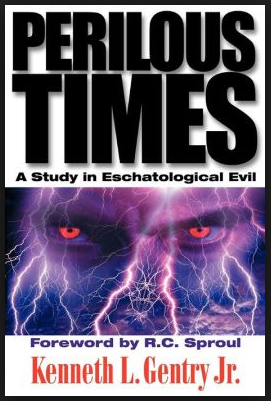
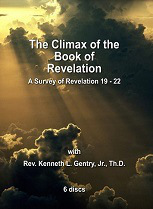








December 6, 2016
ACTS 24:15 AND THE RESURRECTION (2)
PMT 2016-089 by Kenneth L. Gentry, Jr.
In my previous article, I began a brief consideration of Acts 24:14–15. This passage is often used by Hyper-preterists in an attempt to demonstrate that the corporate, public, universal, systematic Christian faith has not been mistaken on one of its foundational doctrines for 2000 years. They mistakenly hold that this passage points to the expectation of a first-century resurrection of the dead.
In my opening article I focused on the lexical issues involved in the key term mellein in this passage. They believe it means “about to,” which it does not. Please read that article to orient yourself to the argument. In this article I will conclude by noting their syntactical and contextual error.
The syntactical data
Second, syntactically when mello appears in conjunction with a future infinitive (as here in Acts 24:15) it indicates certainty. In Acts 24:15 mello appears as mellein, a present active infinite, which becomes a helping verb for the immediately following word esesthai, the future middle infinitive of eimi (“to be”).
The Baur-Arndt-Gingrich-Danker Lexicon states: “With the future infinitive mello denotes certainty that an event will occur in the future.”
The phrase appearing in Acts 24:15 occurs only two other times in the New Testament (Acts 11:28 and 27:10). But it also appears in Josephus, and in a closely related construction in Diognetus.
In Acts 27:10 Paul warns the captain of the ship he was on: “Men, I perceive that the voyage will certainly be [mellein esesthai] with damage and great loss.” The pilot and the captain of the ship disagreed and forged ahead. Paul was prophesying the ship’s wrecking as a certain event.
Nourishment from the Word
(by Ken Gentry)
Reformed studies covering baptism, creation, creeds, tongues, God’s law, apologetics, and Revelation
See more study materials at: www.KennethGentry.com
In Acts 11:28 Agabus prophesies “that there would certainly be [mellein esesthai] a great famine all over the world.” And we read that it most certainly did come to pass in the reign of Claudius.
In fact, in the Exegetical Dictionary of the New Testament (2:403) we read that “in Acts mello contains no suggestion of a near future.”
In Josephus’s Antiquities of the Jews 13:12:1 the same phrase is used of a certain future occurrence:
“The occasion of which hatred is thus reported: when Hyrcanus chiefly loved the two eldest of his sons, Antigonus and Aristobutus, God appeared to him in his sleep, of whom he inquired which of his sons should be his successor. Upon God’s representing to him the countenance of Alexander, he was grieved that he was to be the heir of all his goods, and suffered him to be brought up in Galilee. However, God did not deceive Hyrcanus; for after the death of Aristobulus, he certainly [mellei esesthai] took the kingdom.”
In Diognetus 8:2 we read: “Dost thou accept the empty and nonsensical statements of those pretentious philosophers: of whom some said that God was fire (they call that God, whereunto they themselves shall go [mellousi choresein], and others water, and others some other of the elements which were created by God?”
This is why none — not one — of the standard translations of the Acts 24:15 translate mello as expressing nearness. Rather they translate it simply as a future, certain event (see: KJV, ESV, NEB, NIV, NAB, NKJV, NRSV, etc.). The NASB (cited above) has an excellent rendering: “having a hope in God, which these men cherish themselves, that there shall certainly be a resurrection of both the righteous and the wicked.”
This is why, also, we do not find Acts 24:15 used by liberals to show the error of prophecy in the Bible. That is, no liberal commentator points to this verse as evidence that Paul made a mistake, though they point out other near-term passages as involving error (though they wrongly interpret those texts): texts such as Mark 9:1 and Matthew 24:34.
For instance, we note that Mark 9:1 is brought up as an error for expecting the near-term return of Christ in: The Intepreter’s Bible, The New Century Bible Commentary, and Meyer’s New Testament Commentary. But Acts 24:15 is never mentioned as such in these commentaries.
The contextual data
Third, contextually: Paul’s argument in Acts 24 supports this idiomatic usage of the certainty of the resurrection, rather than of its nearness.
Paul is on trial for his life, having been brought to court by Jews. His clever maneuver is to divide his opponents against themselves: the Pharisees believe in a resurrection of the dead; the Sadducees do not (cp. Acts 23:6–7). Thus, Paul argues for the certainty of the resurrection (by use of this idiomatic expression, mello esesthai) and concludes: “For the resurrection of the dead I am on trial before you today” (Acts 24:21). He is not on trial for declaring the resurrection is near, but is attempting to gain the hearing of the Pharisees over against the Sadducees on the fact of the resurrection.
Getting the Message
(by Daniel Doriani)
Presents solid principles and clear examples of biblical interpretation.
See more study materials at: www.KennethGentry.com
Note also a little more fully what he states as he defends his Christianity (called “the Way”): “But this I admit to you, that according to the Way which they call a sect I do serve the God of our fathers, believing everything that is in accordance with the Law and that is written in the Prophets; having a hope in God, which these men cherish themselves, that there shall certainly be a resurrection of both the righteous and the wicked” (Acts 24:14–15).
Consider two further important observations: Here he is asserting the resurrection as (1) a fact of Scripture (i.e., the Old Testament) and (2) as being held by the Jews (the Pharisees and their followers) themselves. He declares it a fact of Scripture when he states: “believing everything that is in accordance with the Law and that is written in the Prophets.” And he also declares that “these men cherish [this truth] themselves.” We see the resurrection in the Old Testament (e.g., Job 19:25–27; Isa 26:19) and in intertestamental Judaism (e.g., 2 Macc 7:9, 14, 23; 12:43; 1 Enoch 51:1; Josephus, Wars of the Jews 2:8:14; Antiquities 18:1:3).
He is surely not arguing that the Old Testament prophesied that the resurrection would occur “soon”! Nor would he be affirming that the Pharisees believed it was fast approaching. He is speaking of its certainty not its nearness. Thus, the Hyper-preterist use of this verse is erroneous.









December 2, 2016
ACTS 24:15 AND THE RESURRECTION (1)
 PMT 2016-088 by Kenneth L. Gentry, Jr.
PMT 2016-088 by Kenneth L. Gentry, Jr.
Hyper-preterism may be a small movement, but it is a vociferous one. Hyper-preterists believe that the eschatological expectations in Scripture were all fulfilled in the destruction of the temple in AD 70 which closed the old covenant era. Though they are correct in noting the overlooked significance of AD 70, they are incorrect in applying all eschatology to that event.
One of their favorite passages is Acts 24:14–15. In this passage we come upon passage that is significant to the debate. There Paul writes:
But this I admit to you, that according to the Way which they call a sect I do serve the God of our fathers, believing everything that is in accordance with the Law and that is written in the Prophets; having a hope in God, which these men cherish themselves, that there shall certainly be a resurrection of both the righteous and the wicked.
This text is re-interpreted by Hyper-preterists in order to counter the historic Christian position on the resurrection. The evidence that the Hyper-preterist draws from this text is supposedly found in the Greek phrase that is here translated: “there shall certainly be a resurrection.” The Greek words behind this English translation are: anastasin mellein esesthai.
Hyper-preterism seizes upon the word mellein (from the Greek verb mello) and argues that it should be translated “about to.” That is, they would translate this phrase: “there is about to be a resurrection.” According to them, therefore, Paul is stating that he is expecting the resurrection to occur soon (i.e., at AD 70).
Have We Missed the Second Coming: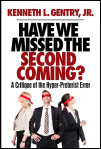
A Critique of the Hyper-preterist Error
by Ken Gentry
This book offers a brief introduction, summary, and critique of Hyper-preterism. Don’t let your church and Christian friends be blindfolded to this new error. To be forewarned is to be forearmed.
For more Christian educational materials: www.KennethGentry.com
Unfortunately for the Hyper-preterist, this is a misreading of Paul that they wrongly employ to support their theological error. In this two-part series on Acts 24:14–15 I will demonstrate the lexical, syntactical, and contextual errors inherent in the Hyper-preterist analysis. I will deal with the first of these in the current article, then the other two in the next one. So, let’s begin with the:
The lexical data
First, lexically the word mello has several possible meanings. That is, it does not simply mean “about to,” as the Hyper-preterist argument requires. Indeed, it is a rather ambiguous term. Greek scholar Daniel B. Wallace has written an important Greek grammar titled, Greek Grammar: Beyond the Basics: An Exegetical Syntax of the New Testament (1996). On p. 536 of this work he speaks of “the ambiguity of the lexical nuance of mello (which usually means either ‘I am about to’ [immediacy] or ‘I will inevitably’ [certainty]).”
This is widely recognized by lexicographers. For instance, the Exegetical Dictionary of the New Testament (2:404) declares: “Clearly … mello does not always have a fixed meaning.”
Below I will cite a few technical sources for the definition and explanation of mello. Please be aware: when I cite these lexical sources I will expand the abbreviated (space-saving) terms rather than encumber the reader with [bracketed] expansions. Other than this, the citations are exact.
The Baur-Arndt-Gingrich-Danker Lexicon exposes some of the ambiguity by offering the following definitions of mello:
“1. to take place a future point of time and so to be subsequent to another event, be about to, used with an infinitive following…. 2. to be inevitable, be destined, inevitable…. 3. The participle is used absolutely in the meaning (in the) future, to come…. 4. delay….”
In the Louw-Nida Greek-English Lexicon of the New Testament Based on Semantic Domains (vol. 1) we read the three leading meanings of mello:
“mello: to occur at a point of time in the future which is subsequent to another event and closely related to it — ‘to be about to.’” (p. 636)
“mello: to be inevitable, with respect to future development — ‘must be, has to be.’” (p. 672)
“mello: to extend time unduly, with the implications of lack of decision — ‘to wait, to delay.’” (p. 646).
In the Exegetical Dictionary of the New Testament (2:403) we read the following definitions: “intend, be about to, will (as auxiliary verb for the future), be destined to; consider, hesitate, delay.”
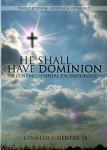
He Shall Have Dominion
(paperback by Kenneth Gentry)
A classic, thorough explanation and defense of postmillennialism (600+ pages). Complete with several chapters answering specific objections.
See more study materials at: www.KennethGentry.com
The ambiguity of mello is clearly seen in these lexical definitions. The term can even have opposite meanings, speaking either of a soon-coming event or a delay! It is not helpful to a new movement to base an important argument on the single appearance of an ambiguous verb in an attempt to overthrow 2000 years of Christian orthodoxy. This lexical evidence alone renders void this particular Hyper-preterist argument. But this evidence does not stand alone: there is more!
To be continued in the next article.








November 29, 2016
POLITICAL POSTMILLENNIALISM (2)
 PMT 2016-087 by J. Vaden Cavett
PMT 2016-087 by J. Vaden Cavett
(This is Part 2 of a study began in the last blog posting)
In Deuteronomy 28 the Lord declares the curses that will fall upon Israel if they break covenant. One feature of this malediction is to be found in verse 30. It reads, “You shall betroth a wife, but another man shall ravish her. You shall build a house, but you shall not dwell in it. You shall plant a vineyard, but you shall not enjoy its fruit.” This curse is pronounced as a covenant sanction for those with whom God was making covenant. As we know, like Adam they transgressed the covenant; there they dealt faithlessly with the Lord (Hosea 6:7). So, God promises to make a New Covenant based upon better promises. Isaiah refers to this New Covenant as The New Heavens and Earth.
“For behold, I create new heavens and a new earth, and the former things shall not be remembered or come into mind. But be glad and rejoice forever in that which I create; for behold, I create Jerusalem to be a joy, and her people to be a gladness. I will rejoice in Jerusalem and be glad in my people….They shall build houses and inhabit them; they shall plant vineyards and eat their fruit. They shall not build and another inhabit;they shall not plant and another eat; for like the days of a tree shall the days of my people be, and my chosen shall long enjoy the work of their hands. They shall not labor in vain or bear children for calamity, for they shall be the offspring of the blessed of the Lord, and their descendants with them…. The wolf and the lamb shall graze together; the lion shall eat straw like the ox, and dust shall be the serpent’s food. They shall not hurt or destroy in all my holy ?mountain, ‘says the Lord.” (Isaiah 65:17-25)
Prodigal Press: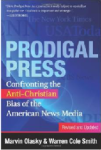
Confronting the Anti-Christian Bias of the American News Media
By Marvin Olasky and Warren Cole Smith
Issuing a clarion call for Christians to reclaim American journalism, Olasky and Smith examine the influence of worldviews on reporting, objectivity, sensationalism, and crusading; the impact of legal, ethical, and technological changes; and the changes brought about by the 24/7 news cycle, the Internet, and social media.
See more study materials at: www.KennethGentry.com
There are several striking features of this prophecy. First, this passage is undeniably covenantal. In the New Heavens and Earth the covenant curses of the Old Covenant will be turned into benediction (vv. 21-22). Also, this passage takes place during the same period as Isaiah 11, which we already established takes place in the latter days, which Isaiah describes in chapter two, and which Peter describes as being upon them in his Pentecost sermon. So, if we follow the relationship these passages have to one another, the New Heavens and Earth begins with the resurrection of Christ, the second Adam, the New Man. We live in the New Creation.
So, what does all this mean? This means that Isaiah creates the expectation (which is confirmed by the New Testament) that the Lord’s Messiah (God himself, as is clear from Isaiah 9) will reign and his government shall have no end. Jerusalem shall be a mountain that will consume the earth in the knowledge of God and the nations shall flock to the holy city to inquire about the Messiah. His law will go forth from Jerusalem and the earth will experience unparalleled peace and prosperity. This Kingdom is the Church, the Lord Jesus’ body, and of its increase there will be no end. Christ must reign until he puts all things under his feet and the earth becomes his footstool (1 Corinthians 15).
This doesn’t mean that every individual on earth will be converted; for, it is plain from Jesus’ parables of the Kingdom that there are both scoundrels and saints in its citizenship. The Kingdom of God is made up of wheat and tares that will be sorted at the judgment. The Kingdom is a giant net that engulfs good and bad fish alike, fish that will be picked through at the resurrection. But what implications does viewing the Visible Church as the Kingdom of God have?
Redeeming Pop Culture
by T. M. Moore
Why is it important for us not to ignore the culture around us? How can we engage, influence, and advance pop culture, and how can we put popular forms to good use in God’s kingdom? Moore urges us neither to flee from popular culture nor to immerse ourselves in it blindly.
See more study materials at: www.KennethGentry.com
It must be realized that Jesus explicitly connects his reign and Kingdom with baptism in The Great Commission. In Matthew 28 Jesus tells his disciples that “[all] authority in heaven and on earth has been given to him” (28:18). He continues, “Go therefore and make disciples of all nations, baptizing them in the name of the Father and of the Son and of the Holy Spirit” (28:19). You see, the sign and seal of the New Covenant is the sign and seal of the New Creation in Isaiah 65. Baptism is the badge of citizenship that every citizen of Christendom carries.
The reign of Christ is never ending, and it is explicitly political in Isaiah 9. The government is upon Christ’s shoulder. This means that the reign of Christ is manifested when the law of God goes forth from Zion (the Church) and transforms legislative actions. When the Church is in control of the state, then the peace and prosperity spoken of by the Prophet will come to fruition. Many will doubtless laugh at the idea of peace, even within the Church itself. However, let me remind you that the Church isn’t what it will be. Jesus is still cleansing her of spots and blemishes (Ephesians 5). Also, the Church is constantly growing up into maturity (Ephesians 4). When Christ has put national governments under his feet, his Bride will be ready for the task. But what does this have to do with baptism?
Trinitarian baptism is more than a simple act of obedience to an irrational command given in an age when such signs were thought to be magical. No, baptism is political. Baptism is proof of citizenship in the kingdom of God, and baptism is a vital part of God’s purposes to expand the Kingdom of his Messiah. So, why does baptism matter? It matters because, in it, we are given the status of “citizen”. It is difficult to remain apathetic towards baptism when the political nature of it is realized. We don’t want to find ourselves on the wrong side of history when all is said and done.
When the last enemy, death, is defeated, we don’t want to find ourselves defeated along with it. The nations will flock to the Church and submit to Christ in baptism. The world will be Christianized and the earth will be as full of the knowledge of God as the waters cover the sea. The question we must ask is, will we be among them?

Jonathan Cavett is a writer and instructional designer at an alternative finance company. He is co-founder of TheCovenantHerald.com and their newsletter, The Covenant Quarterly.









November 25, 2016
POLITICAL POSTMILLENNIALISM (1)
 PMT 2016-086 by J. Vaden Cavett
PMT 2016-086 by J. Vaden Cavett
How do we keep our heads up in a shifting political climate? We must rely on a stout, optimistic, and biblical worldview. Pessimistic eschatology works against us as we seek to glorify God in our toil. But biblical optimism is jet fuel in our tanks. Postmillennialism is high octane orthodoxy and it’s about to squeal your tires.
Postmillennialism teaches that the one thousand years of peace described in Revelation 20 will be enjoyed before Jesus returns to judge the quick and the dead. This view is called “postmillennialism” because Christ returns after (post) his millennial reign. The Gospel will prosper, the masses will be converted, and nations and their rulers will submit to King Jesus. This belief is far removed from the prevailing notion that the world is going to Hell in a hand basket.
The persecuted church will be vindicated in the resurrection, and martyrs’ blood will be the engine that drives the Great Commission closer to completion. We mourn their loss, but we know, for them and the nations, it is gain.
Optimism for optimism’s sake is no good, but postmillennialism is more than a club for contrary optimists. Postmillennialism is based upon a plethora of promises that the Lord gives his Church in both the old and new testaments.
The rest of this essay will develop three assertions:
1.) Christ will have dominion over the nations through his Church (the new Jerusalem) before his return.
2.) This dominion has political and cultural consequences.
3.) Baptism is the badge of citizenship in the Kingdom of God.
Consider the following passage closely:
“It shall come to pass in the latter days that the mountain of the house of the Lord shallbe established as the highest of the mountains, and shall be lifted up above the hills; and all the nations shall flow to it, and many peoples shall come, and say: ‘Come, let us go up to the mountain of the Lord, to the house of the God of Jacob, that he may teach us his ways and that we may walk in his paths.’ For out of Zion shall go the law, and the word of the Lordfrom Jerusalem. He shall judge between the nations, and shall decide disputes for many peoples; and they shall beat their swords into plowshares, and their spears into pruning hooks; nation shall not lift up sword against nation, neither shall they learn war anymore.” (Isaiah 2:2-4)

Political Christianity (book)
(by Christian Citizen)
Christian principles applied to practical political issues, including “lesser-of-evils” voting.
See more study materials at: www.KennethGentry.com
You may perhaps be tempted to dismiss any attempt to locate the period which Isaiah describes in history; however, I believe Isaiah is as specific as if he had told us that this would happen at 3 o’clock, Thursday, November 22, 2014. Notice that he starts his prophecy by placing this period in the latter days. Peter used a phrase very similar to this one in describing the fulfillment of Joel’s prophecy in his Pentecost sermon. As the Spirit falls on the Apostles at Pentecost Peter finds himself answering charges of sipping on breakfast wine. He explains that what the people are witnessing is the fulfillment of Joel’s prophecy concerning “the last days”. So, the last (or latter) days began at Jesus’ resurrection. Just as history is divided into the period before Christ’s birth (BC) and the period during which he reigns from Heaven (AD), so the Bible divides history into the times before and after the resurrection of Christ. John, who lived during Jesus’ lifetime, is said by him to be the greatest Old Testament prophet. Though we read of him in the New Testament, he lives under the Old Covenant dispensation of history. It isn’t until after Christ’s resurrection that the New Covenant era begins. Among other things, this is evident by the transition from a seventh day Sabbath under the period of the Law to the Lord’s Day Sabbath under the New Covenant administration. So, when will the blessings described by Isaiah come to fruition? As he plainly states, these things will take place in the latter days.
There is also other evidence that this prophecy is fulfilled by the arrival of the New Covenant upon Jesus’ resurrection. Notice what Isaiah says concerning Jerusalem:
“the mountain of the house of the Lord shall be established as the highest of the mountains, and shall be lifted up above the hills; and all the nations shall flow to it,….. For out of Zion shall go the law, and the word of the Lord from Jerusalem.”
Jerusalem is to play a central role in the government of the nations in the period of history Isaiah describes. How are we to interpret this statement? First, let it be said that God’s revelation is progressive. We know more than David, David knew more than Moses, Moses knew more than Abraham, Abraham knew more than Noah, and Noah knew more than Adam. God reveals himself to humanity progressively in his mighty acts of redemption, and in his commentary upon those acts in Holy Scripture. In light of this, we must be careful to let the New Testament interpret the Old Testament. We must make certain that we are interpreting the Hebrew Scriptures the same way as the Apostles. So, what does the New Testament teach concerning the mountain of the Lord and Jerusalem?
“But you have come to Mount Zion and to the city of the living God, the heavenly Jerusalem, and to innumerable angels in festal gathering, and to the assembly of the firstborn who are enrolled in heaven, and to God, the judge of all….” (Hebrews 12:22-23)

Greatness of the Great Commission (by Ken Gentry)
An insightful analysis of the full implications of the great commission. Impacts postmillennialism as well as the whole Christian worldview.
See more study materials at: www.KennethGentry.com
In the context of this passage, the author of the book of Hebrews contrasts Mount Sinai, which made the people “tremble with fear”, and Mount Zion, Jerusalem, the city of the living God. In this passage the New Covenant assembly of God is described. This assembly of the firstborn has another name, the Church. Christ “is the image of the invisible God, the firstborn of all creation…. And he is the head of the body, the church.” The firstborn from the dead was raised that he may be the firstfruits of a great harvest. Christ, the firstborn, has made his Church a kingdom of Priests (Revelation 1:6). The priesthood replaced the firstborn who were consecrated as holy in Israel; therefore, Christ, the firstborn, reigns as the monarch of a kingdom of firstborns. This is the city of the living God, this is the Church. Simply put, Isaiah looks to the day when the Church of God is a beacon for the nations, and the result will be peace and prosperity when the law goes out from her.
The passage in Isaiah two has two sister passages that describe the same period in greater detail.
“There shall come forth a shoot from the stump of Jesse, and a branch from his roots shall bear fruit…. He shall not judge by what his eyes see, or decide disputes by what his ears hear, but with righteousness he shall judge the poor, and decide withequity for the meek of the earth; and he shall strike the earth with the rod of his mouth,and with the breath of his lips he shall kill the wicked…. The wolf shall dwell with the lamb, and the leopard shall lie down with the young goat, and the calf and the lion and the fattened calf together; and a little child shall lead them. The cow and the bear shall graze; their young shall lie down together; and the lion shall eat straw like the ox. The nursing child shall play over the hole of the cobra, and the weaned child shall put his hand on the adder’s den. They shall not hurt or destroy in all my holy mountain; for the earth shall be full of the knowledge of the Lord as the waters cover the sea. In that day ?the root of Jesse, who shall stand as a signal for the peoples—of him shall the nations inquire, and his resting place shall be glorious.” (Isaiah 11:1-10)
The righteous branch from the root of Jesse has come, and his name is Christ Jesus.
“For I tell you that Christ became a servant to the circumcised to show God’s truthfulness, in order to confirm the promises given to the patriarchs, and in order that the Gentiles might glorify God for his mercy…. Isaiah says, ‘The root of Jesse will come, even he who arises to rule the Gentiles; in him will the Gentiles hope.’” (Romans 15:8-12) 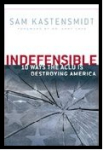
Indefensible (by Sam Kastensmidt)
Sub-title: 10 Ways the ACLU is Destroying America. An Important work in our day of cultural collapse and Christian persecution.
See more study materials at: www.KennethGentry.com
Paul plainly states that the prophecy in Isaiah 11 is being fulfilled in his ministry in history. Notice the similarities between Isaiah 2 and 11. In both of the passages God is judging the nations. In Isaiah 2 it is clear that God is the judge of the nations, but this authority to judge is given to the righteous heir of David in chapter 11. So, in addition to the Lord being an international judge, there is also the mention of Jerusalem. We saw the New Testament’s teaching concerning the Holy Mountain of God and the Heavenly Jerusalem in Hebrews 12; here we see that this mountain is vast.
The earth shall be full of the knowledge of the Lord as the waters cover the sea. This same mountain is described by Daniel in his prophecy (Daniel 2:34-35, 44-45). The Mountain of the Lord, which we saw in Hebrews 12 is the Church of Christ, will fill the whole earth. This is confirmed by Jesus in Matthew 13 where he describes the Kingdom of God as a mustard seed that, while being the smallest of all seeds, grows larger than all the plants and becomes a tree, so that the birds of the air come and make nests in its branches (31-32). Or again, as leaven that a woman took and hid in three measures of flour, till it was all leavened (33). The Kingdom of God is a never ending Kingdom. This is what we celebrate each Christmas when we read the words: “For to us a child is born, to us a son is given; and the government shall be upon his shoulder… Of the increase of his government and of peace there will be no end…” (Isaiah 9:6-7). As these texts emphasize, the reign of Christ will move outward until the earth is as full of the knowledge of God as the waters cover the sea.

Jonathan Cavett is a writer and instructional designer at an alternative finance company. He is co-founder of TheCovenantHerald.com and their newsletter, The Covenant Quarterly.
Click on the following images for more information on these studies:


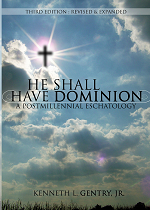








November 22, 2016
THE SIGN OF THE SON OF MAN (2)
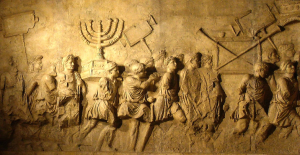 PMT 2016-085 by Kenneth L. Gentry, Jr.
PMT 2016-085 by Kenneth L. Gentry, Jr.
In my preceding article I began answering a reader regarding my interpretation of Matt. 24:30. I believe that the events of AD 70 are the sign of Jesus’s enthronement in heaven. That article should be read before entering into this one. Now I continue my defense of my interpretation (which is not mine, but one that is held by a number of scholars).
Hagner (“Matthew” in Word Biblical Commentary 2:714) points out the LXX backdrop to Matt. 24:30 which is found in Zech. 12:10–14. He notes that in Zech. 12:10–14 “the phrase pansai hai phulai, “all the tribes,” as well as he ge, here meant as ‘the land [of Israel].’” But then he argues that “in keeping with Matthew’s universal perspective, the tribes of the earth, which in the OT originally meant the tribes of Israel, are to be understood all the nations of the earth.” Nolland (“Matthew,” New Intl. Greek Comm., 984) agrees. How can this be said in light of the context?
Noted preterist commentator R. V. G. Tasker “Matthew” in Tyndale NT Comm., 230) writes that Matt. 24:30 refers “to the conditions prevailing when Jerusalem was being attacked.” This fits well with the context, since it has Jesus lamenting Jerusalem’s house being left desolate (Matt. 23:37–38), then his leaving the temple, which prompts the disciples to point out to him the beautiful temple building (Matt. 24:1). Then he prophesies the temple’s destruction (Matt. 24:2) which prompts the disciples to ask “when will these things happen”?
Jesus then launches into the Olivet Discourse, which speaks of “the holy place” (Matt. 24:15) and fleeing from “Judea” (Matt. 24:16), with encouragements to pray that their flight not be on the [Jewish] Sabbath (Matt. 24:20). And all of which is concluded by the near-term statement: “Truly I say to you, this generation will not pass away until all these things take place” (Matt. 24:34). This strongly grounds the statements in the first century era of the destruction of the temple.
What is more both Matt. 24:30 and Rev. 1:7, uniquely combine Dan. 7:13 and Zech. 12:10–14, with both of them set in contexts clearly stating that the events were near (Matt. 24:2, 34; Rev. 1:1, 3). As Nolland (“Matthew,” New Intl. Greek Comm., 989) argues on v. 34: “All the alternative senses proposed here (the Jewish people; humanity; the generation of the end-time signs; wicked people) are artificial and based on the need to protect Jesus from error. ‘This generation’ is the generation of Jesus’ contemporaries.”
Great Tribulation: Past or Future?
(Thomas Ice v. Ken Gentry)
Debate book on the nature and timing of the great tribulation. Both sides thoroughly cover the evidence they deem necessary, then interact with each other.
See more study materials at: www.KennethGentry.com
Thus, the literalistic tendency (evident in Hagner, Nolland, and others) toward the Second Advent in this part of the discourse is surely mistaken. And this bias has led the commentators off in the wrong direction. After all, as Nolland (“Matthew,” New Intl. Greek Comm., 983) notes re: Matt. 24:29: “the highly symbolic language makes it impossible to tell what literal impact on the natural order is expected.” The language certainly is “highly symbolic.” Thus, the interpretive bias is again evident, for this statement appears within the time-frame of Jesus’ generation (Matt. 24:34).
In his Commentary on the New Testament from the Talmud and Hebraica (2:320), John Lightfoot (the famed Hebraist and Rabbinic scholar) argues regarding Matt. 24:30: “Kai tote phanesetai to semeion tou huiou tou antropou, And then shall appear the sign of the Son of man.] Then shall the Son of man give a proof of himself, whom they would not before acknowledge: a proof, indeed, not in any visible figure, but in vengeance and judgment so visible, that all the tribes of the earthy will be forced to acknowledge him the avenger. The Jews would not know him: now they shall know him.”
This parallels in sentiment Jesus’ declaration to the high priest when he was on trial for his life:
Jesus said to him, “You have said it yourself; nevertheless I tell you, hereafter you will see the Son of Man sitting at the right hand of power, and coming on the clouds of heaven. ” (Matt. 26:64)
This was spoken to the then-living high priest with his Sanhedrin gathered around. Jesus was not speaking literalistically as if they would visibly see him in person sitting at God’s throne and coming in the sky. He was clearly affirming his victory following his ascension, after which he would come in judgment against Israel and its high-priestly, old covenant worship system.
In Matt. 24:30 the phrase “of the son of man in heaven” is the genitive of apposition (e.g., A. T. Robertson, Robert H. Mounce). As Mounce (“Matthew,” New Intl. Bib. Comm., 226) expresses it: “the genitive could be construed as an appositive, in which case the sign would be the Son of Man.”
R. V. G. Tasker
Tasker (“Matthew,” Tyndale NT Comm., 225–27) explains Matt. 24:29: “Is it not also possible to regard these verses as a cryptic description in the symbolism of poetry of the Roman conquest of Jerusalem and of the spread of the Christian Church which followed it. The sack of ‘the holy city’ in which over a million people were slain would inevitably appear to those who witnessed it a world-catastrophe of the greatest magnitude; and only language symbolic of cosmic disturbance, such as the darkening of the sun, the failure of the moon to give light, and stars falling from the sky, was adequate to describe it. In using such language Jesus was following the example of the ancient prophets. As Levertoff remarks (p. 80), ‘These are figures, or symbols of divine acts effecting great changes in he world, and are not to be taken literally….’ It may well be, then, that R. A. Knox is right when he says ‘You must understand the portents of verse 29 as an allegorical way of referring to dynastic changes (AD 69-70 was ‘the year of the four emperors’); and you must identify ‘the coming of the Son of man’ in verse 30 with verified experience, e.g. the voice which was heard, according to Tacitus, crying out ‘The gods are departing.’ The type of language used by the Roman historian in the passage from which this quotation is taken is certainly instructive. ‘Contending hosts were seen meeting in the skies, arms flashed, and suddenly the Temple was illumined with fire from the clouds. Of a sudden the doors of the shrine opened and a superhuman voice cried; ‘the gods are departing’: at the same moment the mighty stir of their going was heard.’ The destruction of the Jerusalem Temple was indeed a divine visitation, which one familiar with the language of Jewish prophecy could describe as a coming of the Son of man on the clouds of heaven with power and great glory. It was in fact only after the old ended with the destruction of the Temple that world evangelism by the Christian Church, now entirely separate from Judaism, could be conducted in earnest…. Verses describing ‘the signs of the times’ in this chapter invariably refer to events preceding the downfall of Jerusale, and not to events heralding the final coming of the Son of man.”
Have We Missed the Second Coming:
A Critique of the Hyper-preterist Error
by Ken Gentry
This book offers a brief introduction, summary, and critique of Hyper-preterism. Don’t let your church and Christian friends be blindfolded to this new error. To be forewarned is to be forearmed.
For more Christian educational materials: www.KennethGentry.com
John Gill
Hebrew scholar and theologian John Gill (“Matthew” in Gill’s Expositor, 7: 293–295) comments on Matt. 24:29-30:
Gill on Matt. 24:29 (p. 293): “That is, immediately after the distress the Jews would be in through the siege of Jerusalem, and the calamities attending it; just upon the destruction of that city, and the temple in it, with the whole nation of the Jews, shall the following things come to pass; and therefore cannot be referred to the last judgment…. All the following things were to be fulfilled before that present generation, in which Christ lived, passed away, ver. 34, and therefore must be understood of things that should directly, and immediately take place upon, or at the destruction of the city of temple.”
Gill on Matt. 24:30 (pp. 294): “Ver. 30. And then shall appear the sign of the son of man in heaven…. “this [cannot] design the last trumpet at the day of judgment, since of that the text does not speak, … but the son of man self: just as circumcision is called the sign of circumcision, Rom. iv. 11. and Christ is sometimes called a sign, Luke ii. 34. as is his resurrection from the dead. Matt. xii. 39…. he shall appear, not in person, but in the power of his wrath and vengeance, on the Jewish nation; which will be a full sign and proof of his being come: for the sense is, that when the above calamities shall be upon the civil state of that people, and there will be such changes in their ecclesiastical state; it will be as clear a point, that Christ is come in the flesh, and that he is also come in his vengeance on that nation, for the rejection and crucifixion of him, as if they had seen him appear in person in the heavens. They had been always seeking a sign, and were continually asking one of him; and now they’ll have a sign with a witness; they hey had accordingly. And then shall the tribes of the earth, or land, mourn; that I, the land of Judea.”
Gill on Matt. 24:30 (pp. 295: “the same coming of the son of man is intended; not his coming at the last day to judgment; though that will be in the clouds of heaven, and with greet power and glory; but his coming to bring on, and give the finishing stroke to the destruction of that people, which was a dark and cloudy dispensation to them;: and when they felt the power of his arm, might, if not blind and stupid to the last degree, see the glory of his person.”
Navigating the Book of Revelation (by Ken Gentry)
Technical studies on key issues in Revelation, including the seven-sealed scroll, the cast out temple, Jewish persecution of Christianity, the Babylonian Harlot, and more.
See more study materials at: www.KennethGentry.com
Thomas Scott (The Holy Bible containing the Old and New Testaments … Explanatory Notes, Practical Observations, and Copious Marginal References, 1868, p. 110) writes of Matt. 24:29-30: “The clause, ‘immediately after the tribulation of those days,’ restricts the primary sense of them, to the destruction of Jerusalem, and the events which were consequent to it…. The darkening of the sun and moon … denote the utter extinction of the light of prosperity and privilege to the Jewish nation, the unhinging of their whole constitution in church and state…. This would be an evident ‘sign’ and demonstration of the Son of man’s exaltation to his throne in heaven; whence he would come, in his divine providence, as riding upon ‘the clouds of heaven, with power and great glory; to destroy ‘his enemies, who would not have him to reign over them;’ at which events ‘all the tribes of the land’ would mourn and lament, whilst they saw the tokens, and felt the weight, of his terrible indignation.”
And finally, Albert Barnes (Barnes Notes on the New Testament, p. 116) interprets Matt. 24:40 as follows: “The sign of the Son of man. The evidence that Christ is coming to destroy the city of Jerusalem… At the destruction of Jerusalem, the sign or evidence of his coming was found in the fulfillment of these predictions.”
Thus, I believe there is ample evidence to defend the preterist interpretation of Matt. 24:30. I would recommend reading R. T. France’s commentaries on Matthew in The New International Commentary of the New Testament and in Tyndale New Testament Commentary.









November 16, 2016
THE SIGN OF THE SON OF MAN (1)
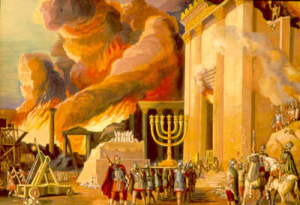 PMT 2016-084 by Kenneth L. Gentry, Jr.
PMT 2016-084 by Kenneth L. Gentry, Jr.
Reader’s question
“Recently I preached on Matt 24:29 and following. In my message I made the point that the in vs. 30 Jesus was making two points. The first being that the destruction of the Temple would indicate to the world that He was now enthroned in heaven.
A Greek scholar in my congregation wrote a long email explaining why this is not what the passage means. He went as far as to say that the people I read and trust on this subject are wrong. I have taken Greek in seminary but I am in no place to argue with him.
Do you have a Greek study/explanation as to why verse 30 can be read with the meaning being that “then will appear the sign of the Son of Man in heaven?”
Gentry’s reply
I would note the following regarding this matter of the proper interpretation of Matt. 24:29–30:
First, we must understand that this is a much debated passage on all sides. It is not a held by a few, recent preterist “populists,” such as Gary DeMar and me. This interpretation cannot be easily written off.
Dispensationalist scholar David L. Turner (“Matthew” in Baker Exegetical Commentary on the New Testament, p. 581, 584) writes of Matt. 24:29–31: “Most scholars understand 24:15–28 to be speaking of events accompanying the destruction of Jerusalem in 70 CE…. There is a similar debate over the prevalent apocalyptic imagery in 24:29–31… Preterist scholars interpret this language as speaking of Jesus’s enthronement in heaven and/or the destruction of Jerusalem on earth.” Then he adds: “preterists … interpret 24:29–31 as symbolizing the theological significance of the temple’s destruction…. The coming of Jesus is viewed as his triumphal arrival in heaven after his resurrection (Dan. 7:13–14). Jesus’s exaltation results in Israel’s judgment, demonstrated by the destruction of the temple by the Romans in 70 CE.”
Prolific commentator Grant Osborne (“Matthew” in Exegetical Commentary on the New Testament, pp. 893–94) writes of Matt. 24:30: “What is the actual sign? Is it the cosmic portents of v. 29 (taking tou hiou tou anthropou as an objective genitive, a ‘sign pointing to the Son of Man,’ so Nolland) or the actual appearing of the Son of Man in this verse (taking it as an appositional genitive, ‘the sign that is the Son of Man’; so Bonnard, Gundry, Schnackenburg, Luz, Bruner)? Or is it separate from both (Hagner), perhaps the resurrection of the saints or the enthronement of Jesus in heaven (France)…? It is impossible to be certain.”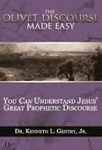
Olivet Discourse Made Easy (by Ken Gentry)
Verse-by-verse analysis of Christ’s teaching on Jerusalem’s destruction in Matt 24. Show the great tribulation is past, having occurred in AD 70.
See more study materials at: www.KennethGentry.com
Thus, Turner recognizes the widespread preterist understanding of this passage, even while he rejects it. And Osborne, who is well-known for his Greek exegetical prowess, deems the interpretation of the passage as uncertain, with the preterist analysis remaining as a live option.
This view has and is held by some noteworthy scholarly authorities, such as noted exegete and Hebrew scholars John Lightfoot (1602–75) and John Gill (1697-1771), as well as famed commentators Thomas Scott (1747–1821), Albert Barnes (1798–1870), and modern day noted commentators R. V. G. Tasker (1895–1976) and R. T. France (1938–2012) to name but a few.
These scholars know their Greek, and as usual, the Greek can be interpreted in different ways. They would hold that the highly symbolic-apocalyptic elements in the passage should not override the clearly literal references to the first century temple (Matt. 23:37–24:2), the local Jewish concerns (Matt. 24:15–16), and the limitation to the first century (Matt. 24:34).
Second, it is important to recognize that this understanding of Matt. 24:29–30 is not absolutely essential to the preterist argument in the overall passage (Matt. 24:1–34; the Discourse does not transition to the Second Advent until v. 36).
Actually it is theoretically possible that Matt. 24:29-30 could refer to the visible signs that Josephus mentions (and which are reported by Tacitus) in the era of the temple’s destruction.
Tasker (“Matthew” in Tyndale New Testament Commentary, p. 26) mentions these reported phenomena: “the voice which was heard, according to Tacitus, crying out ‘The gods are departing.’ The type of language used by the Roman historian in the passage from which this quotation is taken is certainly instructive. ‘Contending hosts were seen meeting in the skies, arms flashed, and suddenly the Temple was illumined with fire from the clouds. Of a sudden the doors of the shrine opened and a superhuman voice cried; ‘the gods are departing’: at the same moment the mighty stir of their going was heard.’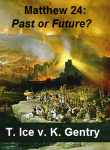
Matthew 24 Debate: Past or Future?
(DVD by Ken Gentry and Thomas Ice)
Two hour public debate between Ken Gentry and Thomas Ice on the Olivet Discourse.
See more study materials at: www.KennethGentry.com
Third, the Greek of the passage will allow for the understanding that the sign is “the Son of Man in heaven.” That is, that the judgments serve as a sign that the Son of Man is enthroned in heaven and is directing the AD 70 judgment.
The two questions that arise in this debate are: (1) How are we to translate ouranos: as “sky” or “heaven” (God’s abode)? (2) How are we to translate the genitive phrase following “the sign” which reads: tou huiou tou anthropou.
Several translations render ouranos as “heaven,” such as the ASV, ERV, ESV, NKJV, NRSV, and Young’s Literal translation. Neither option is necessarily wrong. So the option “heaven” is a possible rendering.
And as numerous scholars note, the genitival phrase “the Son of Man” can be either an objective genitive or an appositional genitive. If it is an objective genitive it would mean that a sign of some sort are pointers to the Son of Man. If it is an appositional genitive it would mean that the sign is the Son of Man himself, whether appearing in the sky or as being enthroned in heaven. Further citations from scholars in the next article will flesh this out.
Click on the following images for more information on these studies:











November 11, 2016
THE FALL AND VICTORY
 PMT 2016-083 by Kenneth L. Gentry, Jr.
PMT 2016-083 by Kenneth L. Gentry, Jr.
The biblical faith is inherently eschatological. God creates the world and has a plan for it. The goal of that plan is necessarily eschatological, for eschatology deals with “the last things.” Consequently, the very beginning of creation has within it the seeds of eschatology. Protology entails eschatology.
In this study I will focus on the sin of Adam in failing God’s test (Gen 2:15-17) which was established on the sixth day of creation (Gen 2 expands on the activities of the sixth day, which is recorded more succinctly in Gen 1:26-30). It is actually in Genesis 3:15 that we have the first genuinely eschatological statement in Scripture (though the creation account involves principles impacting eschatology).
To be sure, in keeping with the progressively unfolding nature of revelation, this prophetic statement lacks the specificity of later, fuller revelation. At this stage in God’s unfolding plan for history the coming Redeemer is not sharply exhibited. Later revelation will gradually fill out the picture, a picture not perfectly full until Christ actually comes at his first advent (Gal 4:4). Yet the broad outlines drawn by this original statement are clear enough, particularly in light of the fuller New Testament revelation.
Adam in the New Testament 
by J. P. Versteeg
Carefully examining key passages of Scripture, Versteeg proves that all human beings descended from Adam, the first man. He argues that if this is not true, the entire history of redemption documented in Scripture unravels and we have no gospel in any meaningful sense.
See more study materials at: www.KennethGentry.com
Orthodox Christians recognize that “the seed of the woman” in Genesis 3:15 refers to Christ. Here Scripture promises that he will crush his great enemy. This enemy is undoubtedly Satan, for later Scripture informs us that he is “the serpent of old [i.e., the ancient serpent], who is the devil and Satan” (Rev 12:9; 20:2). He heads up his evil kingdom (Matt 25:40, 45; Luke 10:18; John 8:44; 15:1–7; Acts 13:10; Rom 16:20; 1 Cor 12:12–27; 1 John 3:10; Rev 12:7–9) which opposes Christ and his righteous kingdom.
This verse portrays in one dramatic sentence a mighty struggle between the woman’s seed (Christ and his kingdom) and the serpent’s seed (Satan and his kingdom). Although this text specifically refers to Christ as the Seed (the Hebrew suffix on “heel” is masculine singular), it also involves a collective seed, as well. After all, Eve is called the “mother of all living” (Gen 3:20), not solely the mother of one individual seed.
In his book Interpreting Prophecy (p. 11), Philip Hughes comments: “This first gospel promise, therefore, despite the terse and figurative language in which it is expressed, provides a true perspective of the whole sweep of human history.” He is correct.
In this verse we witness God establishing the covenant of grace in history. Later New Testament revelation records this prophecy’s victorious fulfillment in the death and resurrection of Christ in conquering Satan. It is not still awaiting some distant fulfillment, as we can see in 1 John 3:8; Heb 2:14; Col 2:14,15. Certainly the consummate order following the Lord’s second advents will bring it to its fullest expression, but Christ’s victory has already occurred; Satan is already a defeated foe.

He Shall Have Dominion
(paperback by Kenneth Gentry)
A classic, thorough explanation and defense of postmillennialism (600+ pages). Complete with several chapters answering specific objections.
See more study materials at: www.KennethGentry.com
In this verse we see history’s underlying struggle as Satan resists God’s creational and redemptive purposes. Anthony Hoekema cites Genesis 3:15 as evidence against postmillennialism, asserting that “the expectation of a future golden age before Christ’s return does not do justice to the continuing tension in the history of the world between the kingdom of God and the forces of evil” (Hoekema, The Bible and the Future, 180).
He is mistaken in that he only considers one aspect of this biblical statement. For despite the clearly-stated fact of historical struggle, this poetic datum points to more: a victorious issue by the woman’s seed. After all, later revelation develops the nature of the struggle and its outcome in history. In addition, the verse seems clearly to relate Satan’s death blow to Christ’s heel-wound, which is his crucifixion that occurs at his first coming. Why then may we not refer this victory to Christ’s first coming and his kingdom’s establishment. After all we read in Colossians 2:15 that “He had disarmed the rulers and authorities, He made a public display of them, having triumphed over them through Him.”
Thus, here in Genesis 3:15 we have at prophecy’s very inception, at human history’s very beginning the certain hope of victory. Just as Adam’s fall has a world-wide negative effect, so does God’s salvation: because of the work of the Last Adam in arising from the dead (Ro 5:15ff; 1Co 15:22, 45). Satan’s crushing does not await Christ’s consummational victory over Satan. The superior strength and glory of Almighty God the Creator through Jesus Christ will progressively overwhelm Satan the Destroyer, his nefarious kingdom, and its evil effects.
This passage underscores postmillennialism rather than scores against it.









Kenneth L. Gentry Jr.'s Blog
- Kenneth L. Gentry Jr.'s profile
- 85 followers



